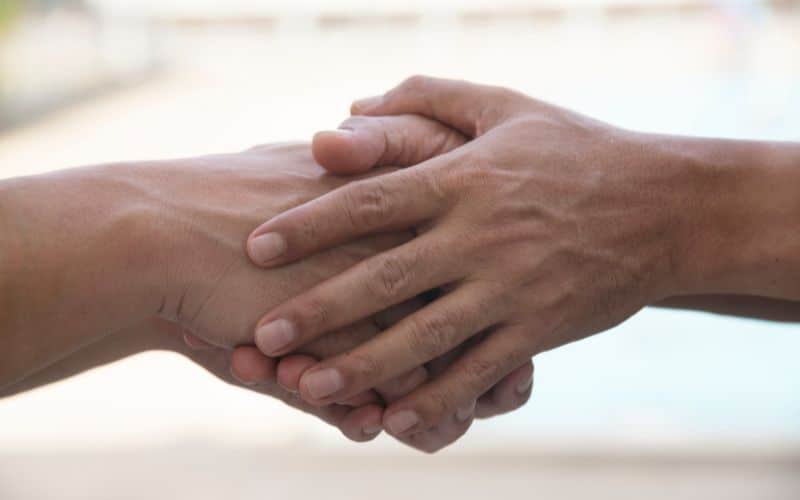Can we live with compassion without practicing mindfulness? Do both need to exist to lead an engaged and present life? Is mindfulness a component of compassion, or is it the other way around?
For years, I’ve strived to lead a mindful and compassionate life. It may seem easy to be kind to everyone and enjoy the beauty of the present moment (or the “here and now,” as some might refer to it). To tune into ourselves, we need to stay open and vulnerable to whatever arises. And yet, the next thing we know, we’re looking for a snack to eat, checking our phones, or doing anything else to distract us.
So, before we go any further, let’s try out a brief mindfulness and compassion exercise.
Mindfulness Exercise
Sit up straight and make sure your feet are firmly planted on the floor. Feel the ground beneath your feet, and focus on the breath. You don’t need to breathe artificially, just notice the breath as it moves through your body on the inhale, and feel the release of the breath on the exhale. Set a timer for 2 minutes, and continue to follow the breath.
Compassion Exercise
Think about 2-3 people in your life who love and care about you. Sit tall, close your eyes, and breathe in feelings of love through your nose. On the out breath, through the mouth, release a wave of kindness and gratitude for the care they provide. Repeat this practice for each person you would like to send kindness and thanks to.
Here are a few questions to reflect on after doing these exercises:

Welcome to your mindful, compassionate journey. Following the breath, being aware of your thoughts, and expressing thanks and gratitude are quick and powerful techniques you can practice every day. And on our website are many more exercises you can try out, any time, to improve your practice.
But there’s a caveat – we need to be willing to acknowledge our thoughts and accept them for what they are. The moment we identify with our thoughts, they become part of our experience, part of our truth, and we lose the natural connection we have to ourselves. In other words, we move upstairs to our heads, and our thoughts are now in control.
As you read this article, we will return to the exercises above to check in and practice the art of “mindful reading.” We will also try out other techniques to give you actionable and practical tips to make this powerful practice a reality in your daily routine.
But first, we’ll take a look at the definitions and origins of mindfulness and compassion.
Definitions and Origins of Mindfulness and Compassion
Mindfulness
A conscious awareness of the present moment. In its simplest form, mindfulness can be focusing on one task at a time and paying attention to the breath.
Compassion
An awareness of and desire to ease the suffering or hardships of others. A simple example is taking in a stray cat and welcoming it into your home.
With its roots in Buddhism, mindfulness stems from the Ancient Indian word sati, which loosely translates to “awareness” or “attention.” But it was not until Thich Nhat Hanh and Jon Kabat-Zinn made their presence felt in the 1970s that the West began to embrace a practice that goes back some 2,500 years ago.
Kabat-Zinn is known for creating the mindfulness-based stress reduction (MBSR) program, which incorporates mindful meditation, body and emotional awareness, and yoga and movement. Based on this groundbreaking approach, mindfulness-based cognitive therapy (MBCT) developed as a form of therapy combining mindfulness techniques, including awareness of the present moment, guided meditation, and breathwork.
Traditionally, mindfulness was much more than being in the present moment, following the breath, and maintaining an awareness of our actions. Instead, it was about living with compassion, living a whole and full life, and radiating love and kindness to all life.
Compassion traces back to Buddhist practices, and its latin root (passio) and prefix “com” literally translates to “suffer with.” Rather than be consumed by suffering, leading to our own distress, those who act with compassion feel moved in their heart to reduce the suffering of others, often leading to a life of service, volunteering, pitching in and helping in the community, and exhibiting unending kindness.
Emory University offers a Cognitively-Based Compassion Training (CBCT) program
This is a great time to take a break and try out a quick, expansive heart-opening meditation.
After finishing this meditation, what did you feel inside your heart? Did the heartspace feel lighter and more open? Did any thoughts come up that distracted you from tuning in?
Mindfulness has the power to help you process thoughts and emotions, but only if your mind and heart are open to it. Short meditations like this one will help your heart open, little by little each day. Soon, you will feel immense ease, improving your relationships and performance at work.
Compassion and Gratitude
As we strive to lead a compassionate life, we can also work on developing gratitude and a loving appreciation and celebration of our dedication and service. The beauty of gratitude is that it has demonstrated reciprocal benefits and can amplify our ability to tune into the present moment and shift our attention from ruminating thoughts and negative emotions.
Here is a grounding worksheet as you reflect on how gratitude could impact your well-being and mindfulness practice. The practice of grounding can make it easier to observe our thoughts and send unwanted energy down into the ground. Once we clear this energy, the heart opens, the breath softens, and we can express a sense of gratitude for the self-love and self-compassion we cultivate.
For added benefits, try out earthing. Place your feet directly in the sand at the beach or in the soil. When you focus your attention on your feet, it will feel like energy is traveling down into the ground. Numerous studies have shown the benefits of earthing, and you can practice any of our mindfulness meditations at the same time for an even greater boost.

The Scientific Benefits Revealed
Staying aware of the now can be tricky when our thoughts travel to the future or our emotions take us back to our past. But studies continue to show the vast benefits of mindfulness on our wellness. And, it is clear that we can train our minds and hearts to focus on the present. In fact, we can even measure the impact of a mindfulness practice, and check in each day to assess our progress.
From 2012 to 2017, adults practicing mindfulness or meditation tripled, from 4% to over 14%. And youth from the ages of 4 to 17 years rose from 0.6% to about 5.5%. What’s interesting about these stats is that mindfulness is often a solo practice. Yet, families could actually practice together, helping their children develop skills early on.
Moreover, Emory University conducted a study about compassion among foster children. Study benefits included regulating emotions, managing stress, and responding with compassion toward others.
One of the longest running studies on happiness at Harvard has revealed some unique insights: that it’s not just about a focus on the mind, body, and heart that leads to a happy, joyful life, but also the relationships we cultivate.
So, how can we incorporate mindfulness with our partners, our family, and our friends to complement our individual practice? In addition, how can we practice compassion among those we care about?
The Nexus of Mindfulness and Compassion
To alleviate the suffering of others, we need to master our inner awareness and attention. This is where mindfulness comes in – can we truly recognize the impact of helping and potentially healing others if we are not aware of the present moment? If we are simply engaging in acts of compassion to check off a few boxes or receive a pat on the back, are we living our truth?
So, having a daily mindfulness practice can help us stay grounded, aware, and appreciative of ourselves and our efforts to radiate empathy, love, and kindness to others. We go into more depth on how to practice self-compassion and mindfulness in a follow-up article.
Compassion and empathy can be an impactful combination, but even more crucial is to make sure our own house is in order. That is, we must remain strong and grounded against what could be extreme or collective suffering of humanity. If we give too much of ourselves in service of others, a few things might happen:
Here is another exercise to clear unwanted or negative energy and return to a peaceful, light state of being. This can be done each night to help you get a restful and rejuvenated sleep.

Mindfulness and Compassion in the Workplace
So, let’s say you have a regular mindfulness practice at home. You dedicate 10-15 minutes each day, and your heart opens and your confidence grows. You go out to a bar or coffeehouse, and find yourself more social and more at ease. Even your family notes how cheerful and light you seem.
This is exactly how mindfulness can manifest in your life. And with this newfound presence and calmness, you can take this energy into the workplace.
Now, say, you recently got promoted to manager, and your focus is on coaching and the growth of your team. In 1-2 years, your boss says that you could be in for another promotion if you can develop talent under you. And you know the formula that has worked so well for your own growth. How do you extend your mindfulness skills to unlock the talent of your team?
Our mindfulness boosters will enhance your team's confidence and productivity. You are looking to de-stress and leave the office on time and fulfilled. And these exercises are your answer.
Conclusion: How to Practice Mindful Compassion
Let’s revisit the three questions at the beginning of this article:
First, If we want to lead with compassion but are not mindful of our energy, we could experience burnout. In other words, our kindness to humanity will not be sustainable in the long run. Second, we can develop our mindfulness practice to create a foundation for compassion. In this way, mindfulness may be a component of compassion, but can also stand on its own.
To boost your mindfulness, compassion, and gratitude practice, check out our Complete Mindfulness Toolkit. Included in this dynamic package are the following resources:


















